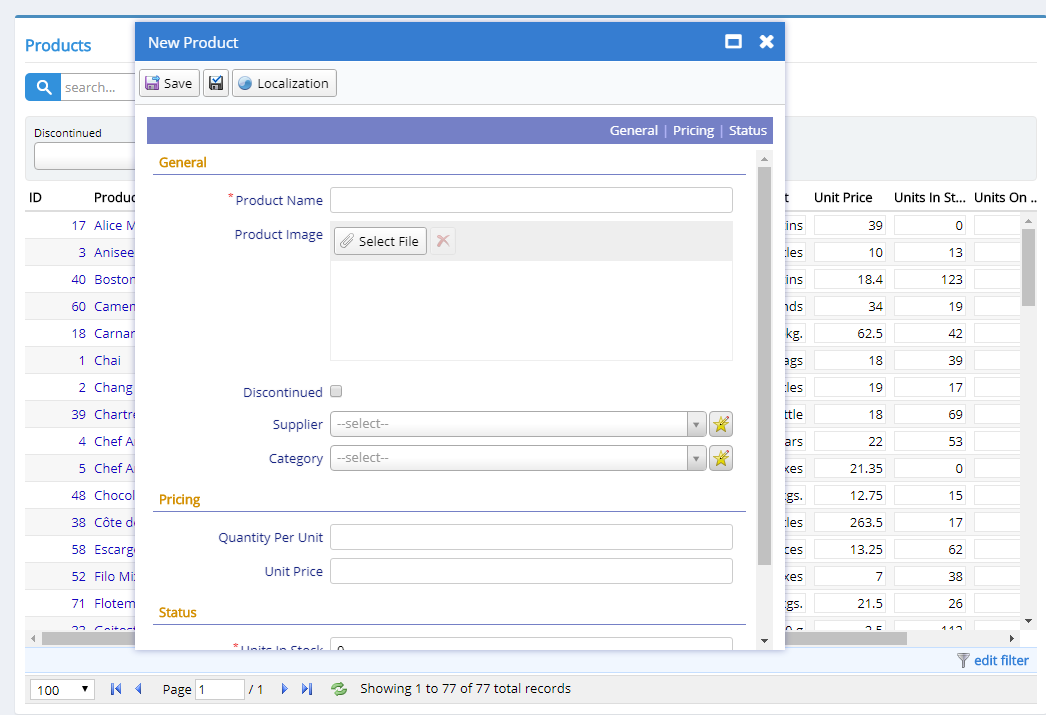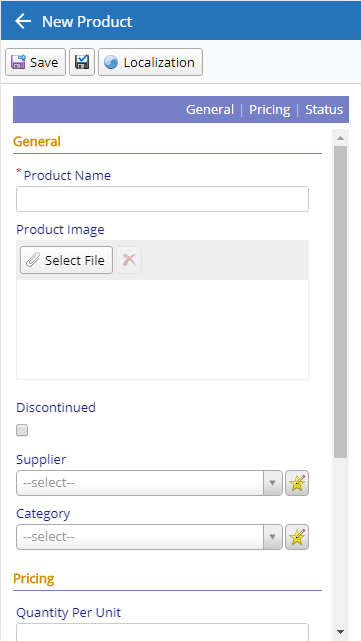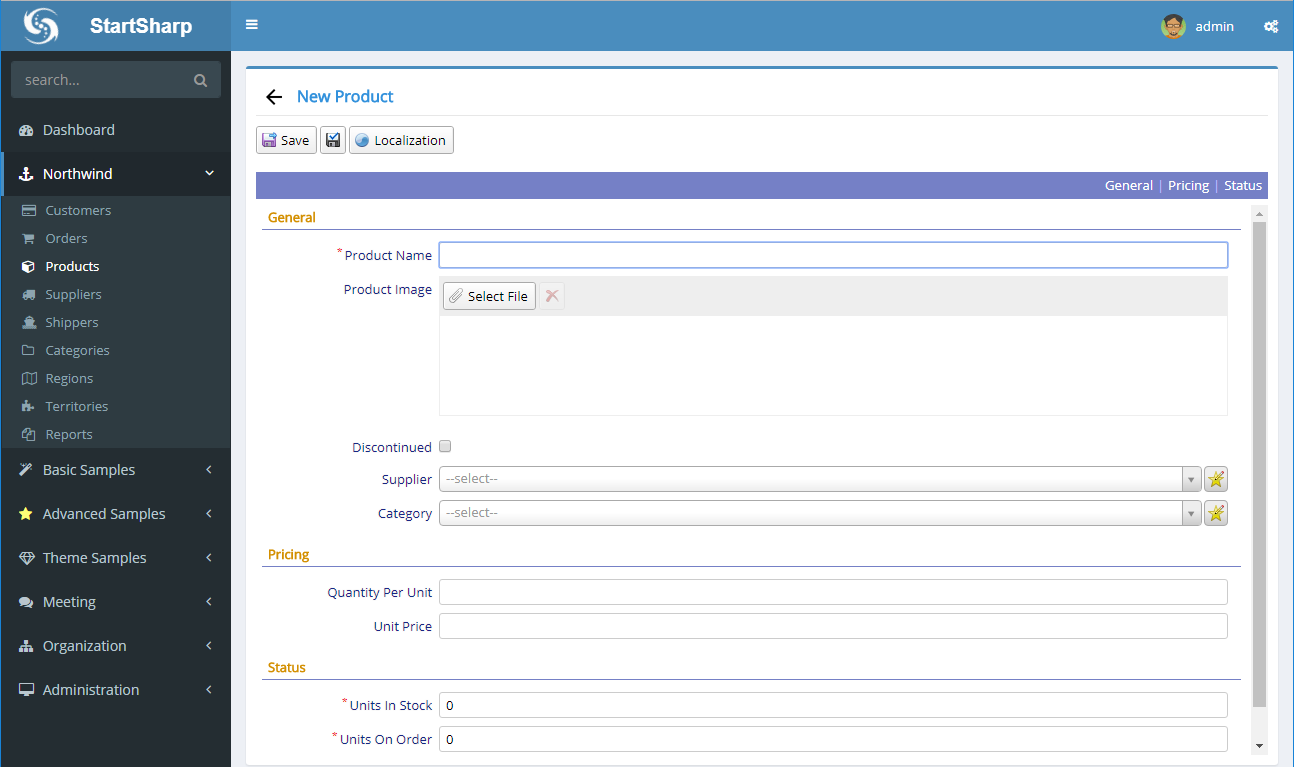Classic Dialog UI
Here is our classic product dialog from Northwind module:

It is draggable and maximizable, like desktop windows. Some of our users praise how familiar it looks and works for end users, which we generally agree.
It uses jQuery UI dialog widget under the hood, but you may not see any jQuery UI specific code by looking at ProductDialog source:
namespace StartSharp.Northwind {
@Serenity.Decorators.registerClass()
@Serenity.Decorators.maximizable()
export class ProductDialog extends Serenity.EntityDialog<ProductRow, any> {
protected getFormKey() { return ProductForm.formKey; }
protected getIdProperty() { return ProductRow.idProperty; }
protected getLocalTextPrefix() { return ProductRow.localTextPrefix; }
protected getNameProperty() { return ProductRow.nameProperty; }
protected getService() { return ProductService.baseUrl; }
protected form = new ProductForm(this.idPrefix);
}
}
These details are handled by our EntityDialog base class which is in turn a subclass of TemplatedDialog that actually creates a jQuery UI dialog.
@Serenity.Decorators.maximizable() on top of our class makes it a maximizable dialog. This is the only dialog specific code we have here actually.
It's possible to customize some dialog parameters by overriding getDialogOptions method but for now let's keep focus on the panel system.
Responsive Dialogs
When you open same page and dialog in a mobile device (or resize browser window), UI changes into a mobile friendly layout:

This is fully automatic and is again handled by TemplatedDialog base class.
The product form you see is still based on jQuery UI dialog, but as jQuery UI itself is not so mobile-friendly, we use some CSS and tricks to make it look like a full page responsive layout.
The Panel Decorator
What if you wanted to have a full page UI, even in desktop devices? Well, you could auto maximize the dialog on open but this wouldn't be ideal as it would also hide navigation.
Serenity 3.1+ turns dialog classes with @Serenity.Decorators.panel() decorator into full page panels.
The decorator isn't new, but automatic behavior is.
Let's add the decorator to ProductDialog class:
namespace StartSharp.Northwind {
@Serenity.Decorators.registerClass()
@Serenity.Decorators.maximizable()
@Serenity.Decorators.panel()
export class ProductDialog extends Serenity.EntityDialog<ProductRow, any> {
protected getFormKey() { return ProductForm.formKey; }
protected getIdProperty() { return ProductRow.idProperty; }
protected getLocalTextPrefix() { return ProductRow.localTextPrefix; }
protected getNameProperty() { return ProductRow.nameProperty; }
protected getService() { return ProductService.baseUrl; }
protected form = new ProductForm(this.idPrefix);
}
}
We only added @Serenity.Decorators.panel() line and here is the result:

We could actually remove maximizable decorator now as it is not used in panel mode. But, it is possible to explicitly open a panel in dialog mode when required, so maximizable might still be useful in that case.
Now we don't have a Close button but a Back button instead. As panel is already full page, maximize button is not shown in this mode.
One thing we should also note is, unlike responsive dialog sample before, where we still had a jQuery UI dialog and styled it, no jQuery UI dialog is created in this mode.
Opening a Panel in Dialog Mode (or vice-versa, Dialog in Panel Mode)
@Serenity.Decorators.panel() only controls the default mode UI should operate in.
It is possible to open a dialog with panel attribute in dialog mode (or vice-versa) when required:
You may type these in a browser console, or write them on a button click event (replace StartSharp with your namespace):
// force widget to open in dialog mode
var dlg1 = new StartSharp.Northwind.ProductDialog();
dlg1.loadNewAndOpenDialog(false);
// force widget to open in panel mode
var dlg2 = new StartSharp.Northwind.ProductDialog();
dlg2.loadNewAndOpenDialog(true);
// auto decide open mode, e.g. if class has a panel
// decorator open in panel mode widget to open in panel mode,
// otherwise open in dialog mode. this is the default.
var dlg3 = new StartSharp.Northwind.ProductDialog();
dlg3.loadNewAndOpenDialog();
When loadNewAndOpenDialog is called with no parameters, it checks if class has a panel decorator. If it has, it opens in panel mode, otherwise in dialog mode.
If you pass false to loadNewAndOpenDialog it forces to open widget in dialog mode, even if it has a panel decorator.
If you pass true to loadNewAndOpenDialog it forces to open widget in panel mode, even if it doesn't have a panel decorator.
There are other similar methods like dialogOpen() and loadEntityAndOpenDialog() that accepts this asPanel boolean flag and operates similarly.
Overriding Dialog/Panel Mode for a Specific Grid
There may be cases when a dialog class has panel attribute, but for a specific grid, you may want its dialogs that is shown when you click Add button or click an edit link to open in dialog mode, or the opposite.
Grids now has openDialogsAsPanel property which is null, e.g. auto by default, but it is possible to set it to false to force dialogs launched from this grid open in dialog mode, or true to open in panel mode.
export class ProductGrid extends Serenity.EntityGrid<ProductRow, any> {
//...
constructor(container: JQuery) {
super(container);
// force new and edit item dialogs to open in panel mode
this.openDialogsAsPanel = true;
}
This property is also settable from outside the grid class (e.g. public property), so you might force a grid class to open its dialogs in panel mode in some page, while dialog mode in another.
Conclusion
Turning your classic dialog into a mobile friendly, full page panel is a nice addition to Serenity, and the best part is it is just a one liner.
We recommend this mode as default for dialogs with large forms.
As a bonus, panel mode is more compatible with bootstrap grid layout, which we'll talk in a future post.